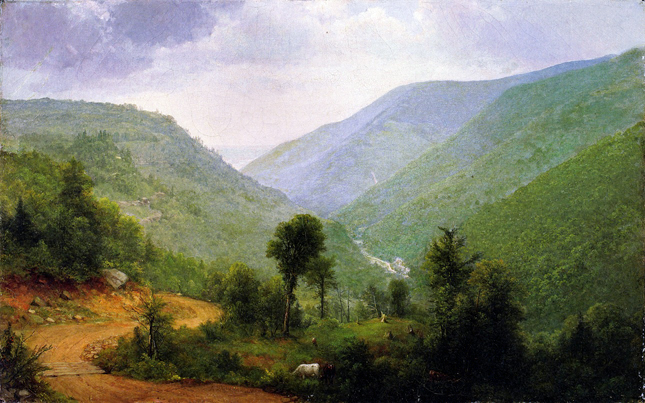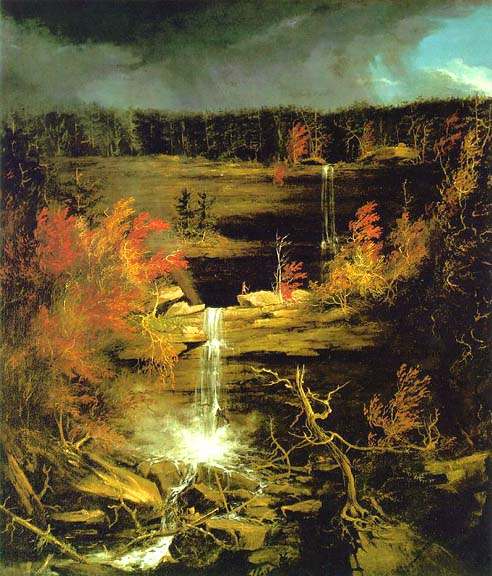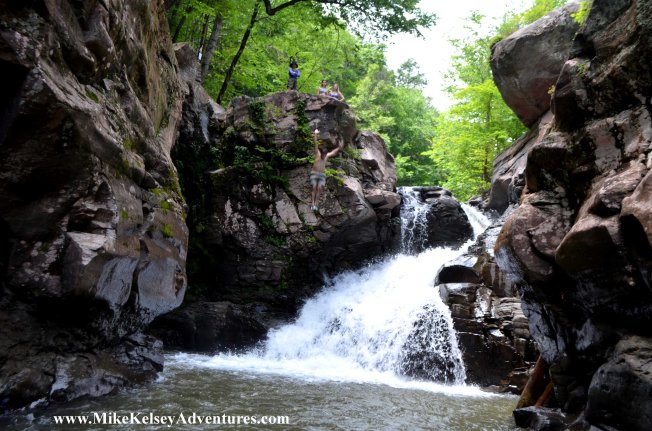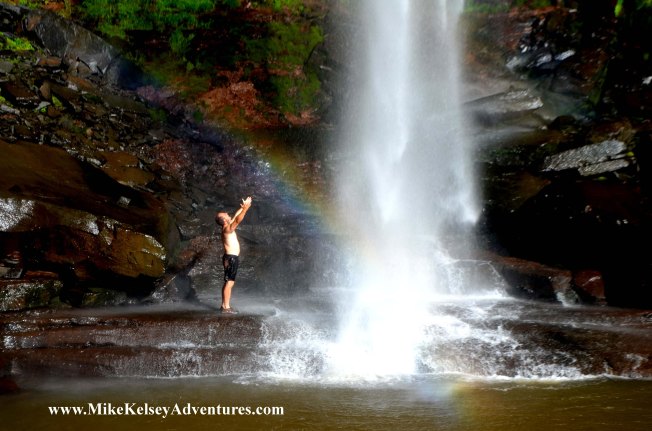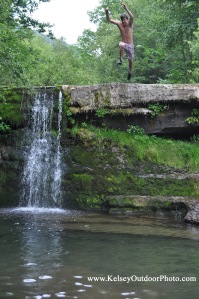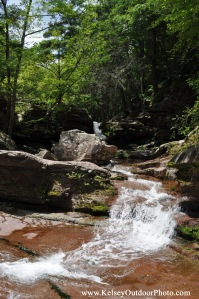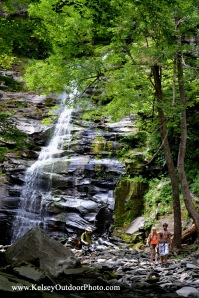One hundred and fifty year ago this month, Asher B. Durand stood where we now stand to paint the Kaaterskill Clove. While a century and a half lay between us, the view of the glacier-carved ravine (South Mountain to the north, Kaaterskill High Peak and Roundtop Mountain on our right) still closely resembles Durand’s 1864 painting, “Catskill Clove, NY.” The Hunter Turnpike in the foreground has now been paved, but the densely forested mountains still slope 2,500 feet to the Kaaterskill Creek where only hours from now we will walk.
The Catskill Mountains, sundered by v-shaped gorges that  the Dutch called cloves, is filled with running rivers whose downward flow burgeons into countless cascades. Mid-19thcentury painters popularized the area on their canvas leading to a national movement to come and see nature’s awesome grandeur up close, breathe its fresh air and listen to the sounds of its inspirational musings. Perhaps the capstone of this Grand American Tour was the viewing of the twin cataracts of Kaaterskill Falls, which before dropping into the clove for our river scramble we too seek out.
the Dutch called cloves, is filled with running rivers whose downward flow burgeons into countless cascades. Mid-19thcentury painters popularized the area on their canvas leading to a national movement to come and see nature’s awesome grandeur up close, breathe its fresh air and listen to the sounds of its inspirational musings. Perhaps the capstone of this Grand American Tour was the viewing of the twin cataracts of Kaaterskill Falls, which before dropping into the clove for our river scramble we too seek out.
Our hike begins north of the clove with a river-trek up Lake Creek. We hike directly in the stream, experiencing the chill, the flow, and the natural force of the river current.
 Our water quest starts strong. Almost immediately we encounter Bastion Falls, a 71-foot three-tiered waterfall of impressive flow. We approach close to lean our heads into its vertical current, and on this hot summer day we climb high on rock ledges to further experience its upper pelting flumes. After dithering for the greater part of an hour soaking, contemplating,
Our water quest starts strong. Almost immediately we encounter Bastion Falls, a 71-foot three-tiered waterfall of impressive flow. We approach close to lean our heads into its vertical current, and on this hot summer day we climb high on rock ledges to further experience its upper pelting flumes. After dithering for the greater part of an hour soaking, contemplating,  and exploring we continue the half-mile hike to Kaaterskill Falls.
and exploring we continue the half-mile hike to Kaaterskill Falls.
When the 231-foot tall Kaaterskill comes into view we pause in silent admiration. 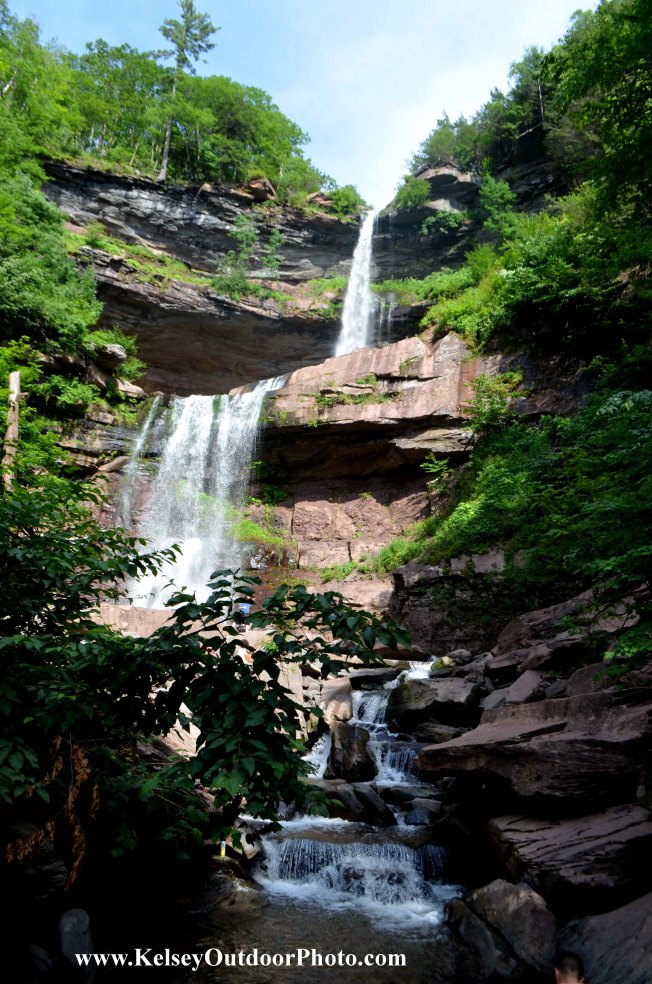 Leafy green foliage frames the postcard-like scene. Water flows as ivory sprays in staggered twin succession over rock ledges of salmon hue. The water now flowing past my feet, only minutes earlier was high atop the cliff before twice plunging off hollowed-out overhangs “like a gush of living light from Heaven.”
Leafy green foliage frames the postcard-like scene. Water flows as ivory sprays in staggered twin succession over rock ledges of salmon hue. The water now flowing past my feet, only minutes earlier was high atop the cliff before twice plunging off hollowed-out overhangs “like a gush of living light from Heaven.”
“Foaming into feathery spray,” continued Thomas Cole in his 1843 observation, it “descends into a rocky basin one hundred and eight feet below; thence the water flows over a platform forty or fifty feet, and precipitates itself over another rock eighty feet in height.” Here, the fast-moving water spouts over a foreground cascade vastly out-shadowed by the layered falls behind. As beads of water condense on my camera lense, I take the obligatory photographs of the scene that Cole more than any other in autumn immortalized on his canvas.
Thomas Cole introduced the world to the Kaaterskill – and to the Catskill Mountains – through his paintings, poems, essays and journals. It spawned not only tourism, but an entire genre of landscape painting including the Hudson River School of Painters, which Cole founded and Durand was among its most illustrious member.
The landscape painting movement was heavily influenced by Nineteenth Century Transcendentalist ideas that stemmed from the pens of Emerson and Thoreau. It held that unspoiled nature was the basis for spiritual renewal, reflection and the restoration of the human spirit. Cole and Durand were believers. We too became disciples.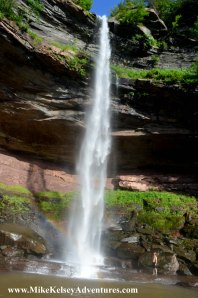
After a steep climb up the side of the first falls we follow a faint pathway leading to the base, where the column of water drains into a large pool. Our group disperses, each reflecting silently upon the paradise we have found. Some walk directly into the mist as an arching rainbow stretches overhead. A few submerge into the basin. Others soak up rays, sunbathing on rocks. I scramble up the side of the amphitheater for a birds-eye view. Others climb higher to walk on a ledge behind the falls seventy-feet up.
The roaring falls is soothing to the ear. The infinite drops of water pounding onto the base rocks and into the pool also enthralled Cole, who called waterfalls the “voice of the landscape.” I trace the path of the water as it pours over the cliff, into the basin, and then exits over another cliff, only to be replenished by a continuous water stream. Waterfalls, said Cole, “at once presents to the mind the beautiful, but apparently incongruous idea of fixedness and motion – a single existence in which we perceive unceasing change an everlasting duration.”
 With reluctance we journey on. Retracing our steps to Bastion Fall we rock-hop the lower Lake Creek to join up with Kaaterskill Creek. We stop several times en route to refresh in bubbling springs of cold water.
With reluctance we journey on. Retracing our steps to Bastion Fall we rock-hop the lower Lake Creek to join up with Kaaterskill Creek. We stop several times en route to refresh in bubbling springs of cold water.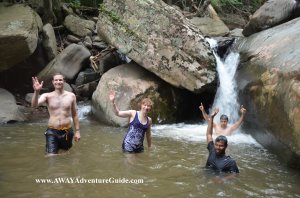
The initial stretch of Kaaterskill Creek is flat, rock-strewn and disinteresting. 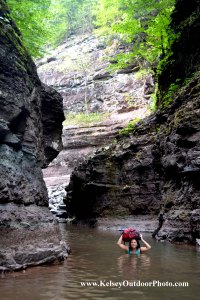
It pales drastically with the day’s  final segment. There, we’ll scuttle through flesh-colored alleyways hemmed in by convoluted sandstone. We’ll wallow in pools, splash in cascades, and slide smooth chutes into the rust-colored streambed. Jettisoning off polished boulders that guard chest-deep pools at a popular swimming hole called “The Rat Hole,” we’ll unabashedly surrender to temptation on this hot humid day.
final segment. There, we’ll scuttle through flesh-colored alleyways hemmed in by convoluted sandstone. We’ll wallow in pools, splash in cascades, and slide smooth chutes into the rust-colored streambed. Jettisoning off polished boulders that guard chest-deep pools at a popular swimming hole called “The Rat Hole,” we’ll unabashedly surrender to temptation on this hot humid day.
For now, the streambed is tame. The shoreline is wooded. Eventually the roaring falls of Fawn’s Leap comes into earshot. Tradition claims a fawn leapt from the falls to escape an Indian hunter. These days, it’s not deer, but teen-agers and families jumping from the 30 and 40-ft cliffs.
We join several bathing-suit-clad groups who have come here 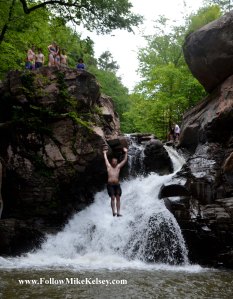 to escape the summer heat.
to escape the summer heat.
The falls twist and tumble fifty-feet to a large pool walled in by thick rock cliffs on both sides.  When it’s my turn I launch myself off the falls without hesitation. The drop lasts only seconds; the exhilaration much longer. I glance up to watch others scurry up side walls; one guy doing back flips.
When it’s my turn I launch myself off the falls without hesitation. The drop lasts only seconds; the exhilaration much longer. I glance up to watch others scurry up side walls; one guy doing back flips.
Fawn’s Leap was a favorite destination of Cole’s. After Cole’s 1848 death, Asher Durant painted him standing atop the Fawn’s Leap overhang, a painting in which Cole was joined by his friend and eulogizer, poet William Cullen Bryant.
Arguably the most famous of the Hudson River School paintings, Durand took artistic license with Kindred Spirits by incorporating into a single frame the iconic Catskill scenery: Fawn’s Leap, Kaaterskill Clove, and the twin cataracts of Kaaterskill Falls.

I look up now to see would-be swimmers standing on the precipice readying to jump. I think of Cole and Durand, whose influence a century and a half ago made this place known. Thankfully the unspoiled beauty remains. As I can attest, its rejuvenating effect does too.
Michael N. Kelsey leads Hudson Valley, Catskill and Adirondack Mountain hiking and kayaking trips. Write him at AWAYAdventureGuide@gmail.com and read his adventure blog at www.MikeKelseyAdventures.com. This article appeared in the June 2014 issue of Berkshire HomeStyle magazine.
Please help me to keep this a free site. If you enjoyed this blog post and would like to see more like it, please make a one-time donation. All donations are used to create additional content.
Make a monthly donation
Make a yearly donation
Choose an amount
Or enter a custom amount
Your contribution is appreciated.
Your contribution is appreciated.
Your contribution is appreciated.
DonateDonate monthlyDonate yearly
